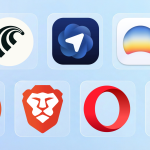Do you remember that time when the Internet was free? When you could have easily visited any website and read any article without having to opt-in in any form or pay for a monthly subscription? Gone are those days, and you can blame both content creators and standard users.
The Internet then versus the Internet now
When I first started blogging, over 15 years ago, there weren’t as many people using Adblock extensions, no one knew about VPN services, and browsers didn’t include built-in blocking systems. Today, things have changed, as many browsers, such as Vivaldi Browser, provide built-in privacy settings, including blocking trackers and ads.
VPN services have also seen many improvements, with well-known companies such as Surfshark VPN providing robust apps and browser extensions that block everything from trackers to ads to anything that’s trying to get or see your information.
While I could give a hundred different examples of how the Internet has changed and involved over the years, standard users focused so much on blocking anything ad-related from any website or app they were using, that website owners had to turn in alternative ways to make money from their content.
Everything started with blocking ad-blockers. That was the easiest way for content creators to increase their ad revenue, locking their content for people who were using ad-block extensions. Some saw a wave of negative reactions from their visitors, while others kept the same strategy, explaining that they had to do that if they wanted to continue running the website.
Others followed softer strategies, such as displaying a simple message to the visitors that they were using ad-block extensions, asking them to kindly disable them. Unfortunately, both of those tactics didn’t help much, although bloggers are keep using them as of today. What came as the biggest change for websites, applications, and other online services, were the subscription-based plans, which are now almost everywhere.
What are subscription-based plans?

Simply put, subscription-based plans are exactly what their name suggests; If you want full access to a website’s content, you’ll have to sign up for an account and get a premium plan. Some of them are pretty cheap, such as $1.99 or $2.99 per month, while other popular websites may have even higher prices.
Usually, premium subscribers would not only get full access to a website’s content, but they also enjoy an ad-free user experience. Some websites may even offer a premium newsletter, a forum, or a closed group, and even links to other types of content, including videos, courses, e-books, and audiobooks.
But is the price worth it? That depends on the website, the content they create, and how happy you are with their current articles, videos, etc. It’s not very different from what you’re already seeing on platforms such as Patreon, a tool for content creators to run a subscription service and sell digital products.
Bloggers aren’t the only ones using subscription-based plans and services, application developers seem to follow the same path. Many apps nowadays give you full access to their content only if you opt-in to one of their premium subscriptions.
How subscription plans help content creators make more money
With content creators trying to increase their revenue as much as possible, continue paying for their website or app’s monthly expenses, and make some bucks themselves, most of them are focusing on leaving their jobs and working full-time on their hobbies. New bloggers looking to become full-time bloggers, and app developers are dreaming of seeing their apps hitting the top lists on the app stores.
To do that, they need to make as much money as they possibly can, and subscription plans seem to be a great choice when it comes to creating standard monthly income from their premium subscribers. And while not everyone is able to build a big audience of premium subscribers, that doesn’t stop new content creators from immediately locking their content with subscription-based plans.
Subscription plans are also more valuable than ads, and that’s because not everyone is clicking on those. Think about it; How many times is a visitor going to click on the ads in a month? Not many, if you ask me, but having them pay every month for full access to your content? Well, that’s a great way to keep the money coming in, and more than you’ll ever make from your ads – although that depends on the number of your subscribers and your website’s monthly traffic.
With all that in mind, it’s understandable why more and more websites are locking their content with subscription-based plans. Ads and sponsored posts simply aren’t enough for many well-known websites to pay their journalists and content creators, and many bloggers feel they can make a whole lot more money than they would traditionally make with ad displayment.
Why I hate that the Internet is now subscription-based
I can’t blame content creators for looking to make more money out of their content. I’m also a full-time blogger after all, and making money from my blogs is important to keep paying for my personal and company’s monthly expenses. While I haven’t implemented in any of my blogs a content subscription system, as I am happy with the revenue that I get from ads, sponsored posts, and affiliate sales, many others are following this path from the beginning.
The issue for most people is money. There are streaming platforms, online courses, e-books, and audiobooks, and with social media platforms already introducing subscription-based plans, and many developers creating subscription-based systems that people can easily install and use on their websites, we pay for way too many different things nowadays.
Every month, my bank account gets filled with a plethora of small bills from online services that I pay. Spotify, Netflix, Microsoft’s 365 subscription, and Notion are among them, just to name a few. Then I have to pay for my web hosting, WordPress plugins, CDN services, VPN, SEO tools that I am using, and so much more. And that’s a list that excludes a few subscriptions that I’ve canceled, including the expensive Adobe’s suite of apps.
The Internet has become expensive, and having full access to most of the websites that you read every day is impossible for most people. At this moment, is important for people to prioritize what is actually important for them, and start canceling everything else – if they want to save money, that means. If you’re a content creator or entrepreneur, you should also prioritize the importance of every social media platform and if you need a subscription to any of them.
What are your thoughts on this matter? Do you agree that the internet has become expensive, and how many subscriptions are you currently paying for? I’d love to hear your thoughts, experience, and ideas on today’s subscription-based Internet in the comment section down below.


















